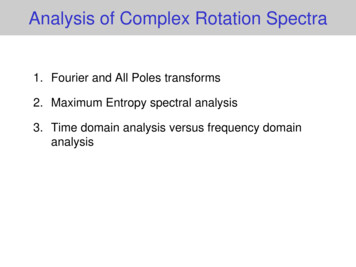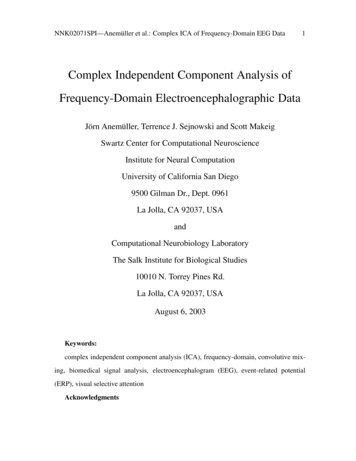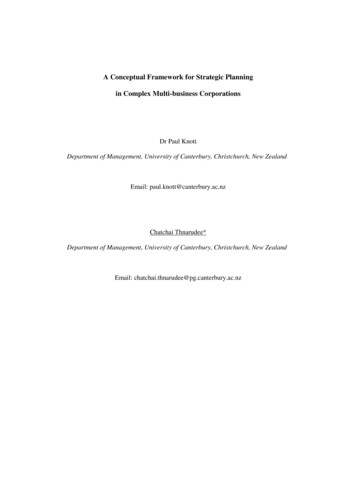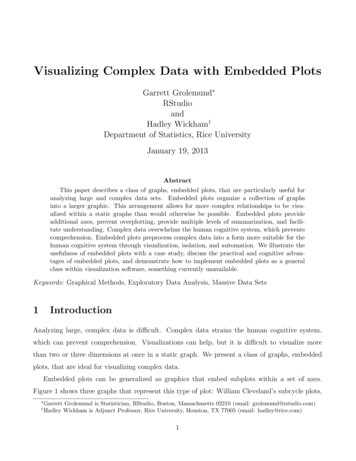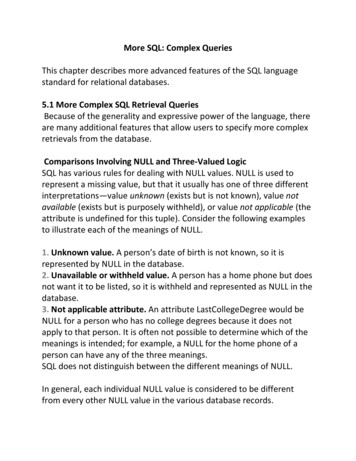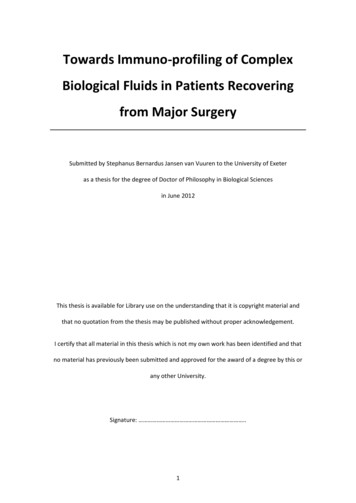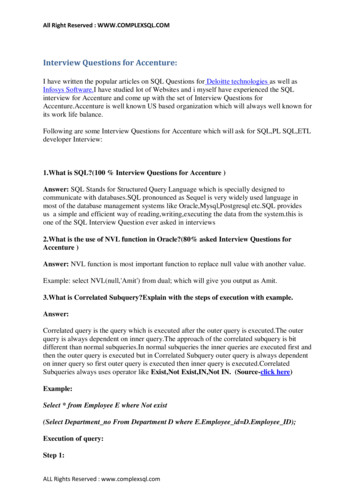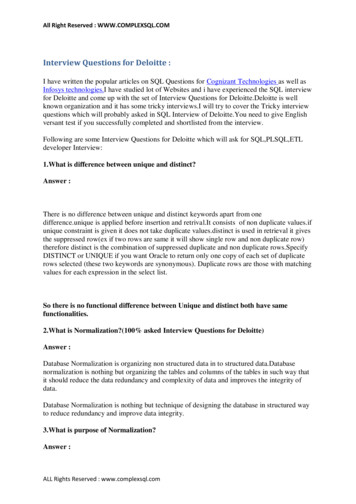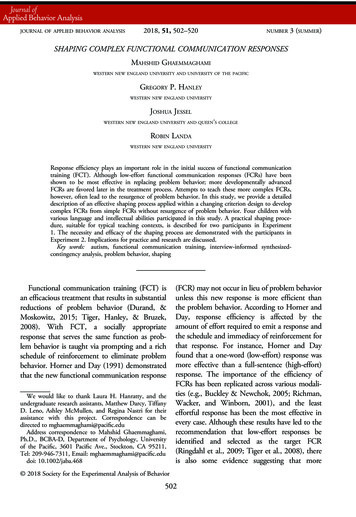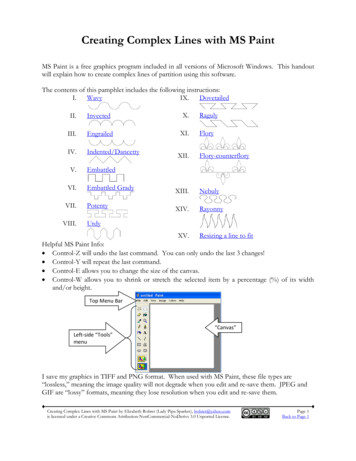
Transcription
COMPLEX ANALYSISAn Introduction to the Theory of AnalyticFunctions of One Complex VariableThird EditionLars V. AhlforsProfessor of Mathematics, EmeritusHarvard UniversityMcGraw-Hill, Inc.New York St. Louis San Francisco Auckland BogotaCaracas Lisbon London Madrid Mexico City MilanMontreal New Delhi San Juan SingaporeSydney Tokyo Toronto
COMPLEX ANALYSISCopyright 1979, 1966 by McGraw-Hill, Inc. All rights reserved.Copyright 1953 by McGraw-Hill, Inc. All rights reserved.Printed in the United States of America. No part of this publicationmay be reproduced, stored in a retrieval system, or transmitted, in anyform or by any means, electronic, mechanical, photocopying, recording, orotherwise, without the prior written permission of the publisher.2223 BRBBRB9876543This book was set in Modern SA by Monotype Composition Company, Inc.The editors were Carol Napier and Stephen Wagley;the production supervisor was Joe Campanella.Library of Congre Cataloging in Publication DataAhlfors, Lars Valerian, dateComplex analysis.(International series in pure and applied mathematics)Includes index.1. Analytic functions. I. Title.QA331.A45 1979515' .9378-17078ISBN M7-000657-1
To Erna
ContentsPrefaceCHAPTER 1122COMPLEX NUMBERS1The Algebra of Complex Numbers11.11.21.31.41.513469Arithmetic OperationsSquare RootsJustificationConjugation, Absolute ValueInequalitiesThe Geometric Representation of Complex Numbers122.1 Geometric Addition and Multiplication2.2 The Binomial Equation2.3 Analytic Geometry2.4 The Spherical Representation1215CHAPTER 21xiiiCOMPLEX FUNCTIONS171821Introduction to the Concept of Analytic Function211.1 Limits and Continuity1.2 Analytic Functions1.3 Polynomials1.4 Rational Functions22242830Elementary Theory of Power Series332.1 Sequences2.2 Series3335vii
viii3CONTENTS2.3 Uniform Convergence2.4 Power Series2.5 Abel's Limit Theorem353841The Exponential and Trigonometric Functions423.13.23.33.442434446The ExponentialThe Trigonometric FunctionsThe Periodicity.The LogarithmCHAPTER 3123449Elementary Point Set Topology501.1 Sets and Elements1.2 Metric Spaces1.3 Connectedness1.4 Compactness1.5 Continuous Functions1.6 Topological Spaces5154596366Conformality672.1 Arcs and Closed Curves2.2 Analytic Functions in Regions2.3 Conformal Mapping2.4 Length and Area67697375Linear Transformations763.13.23.33.43.57678The Linear GroupThe Cross RatioSymmetryOriented CirclesFamilies of Circles50808384Elementary Conformal Mappings894.1 The Use of Level Curves4.2 A Survey of Elementary Mappings4.3 Elementary Riemann Surfaces8993CHAPTER 41ANALYTIC FUNCTIONS AS MAPPINGSCOMPLEX INTEGRATION97101Fundamental Theorems1011.1 Line Integrals1.2 Rectifiable Arcs1.3 Line Integrals as Functions of Arcs1.4 Cauchy's Theorem for a Rectangle1.5 Cauchy's Theorem in a Disk101104105109112
CONTENTS23456Cauchy's Integral Formula1142.1 The Index of a Point with Respect to a Closed Curve2.2 The Integral Formula2.3 Higher Derivatives114118120Local Properties of Analytical Functions1243.13.23.33.4Removable Singularities. Taylor's TheoremZeros and PolesThe Local MappingThe Maximum Principle124126130133The General Form of Cauchy's 46Chains and CyclesSimple ConnectivityHomologyThe General Statement of Cauchy's TheoremProof of Cauchy's TheoremLocally Exact DifferentialsMultiply Connected RegionsThe Calculus of Residues1485.1 The Residue Theorem5.2 The Argument Principle5.3 Evaluation of Definite Integrals148152154Harmonic on and Basic PropertiesThe Mean-value PropertyPoisson's FormulaSchwarz's TheoremThe Reflection PrincipleCHAPTER 512lxSERIES AND PRODUCT DEVELOPMENTS175Power Series Expansions1751.1 Weierstrass's Theorem1.2 The Taylor Series1.3 The Laurent Series175179184Partial Fractions and ial FractionsInfinite ProductsCanonical ProductsThe Gamma FunctionStirling's Formula
x345CONTENTSEntire Functions2063.1 Jensen's Formula3.2 Hadamard's Theorem207208The Riemann Zeta Function2124.1 The Product Development4.2 Extension of t(s) to the Whole Plane4.3 The Functional Equation4.4 The Zeros of the Zeta Function213214216218Normal nuityNormality and CompactnessArzela's TheoremFamilies of Analytic FunctionsThe Classical DefinitionCHAPTER 612345CONFORMAL MAPPING. DIRICHLET'SPROBLEM229The Riemann Mapping Theorem2291.11.21.31.4229232233234Statement and ProofBoundary BehaviorUse of the Reflection PrincipleAnalytic ArcsConformal Mapping of Polygons2352.1 The Behavior at an Angle2.2 The Schwarz-Christoffel Formula2.3 Mapping on a Rectangle2.4 The Triangle Functions of Schwarz235241A Closer Look at Harmonic Functions2413.13.2242243Functions with the Mean-value PropertyHarnack's Principle236238The Dirichlet Problem2454.1 Subharmonic Functions4.2 Solution of Dirichlet's Problem248245Canonical Mappings of Multiply Connected Regions2515.15.25.3252257259Harmonic MeasuresGreen's FunctionParallel Slit Regions
CONTENTSCHAPTER 71232631.1 Representation by Exponentials1.2 The Fourier Development1.3 Functions of Finite Order263264264Doubly Periodic Functions2652.1 The Period Module2.2 Unimodular Transformations2.3 The Canonical Basis2.4 General Properties of Elliptic Functions265266268270The Weierstrass TheoryThe Weierstrass p-functionThe Functions t(z) and u(z)The Differential EquationThe Modular Function A(r)The Conformal Mapping by A(r)CHAPTER 8The Resultant of Two PolynomialsDefinition and Properties of Algebraic FunctionsBehavior at the Critical 7300300301304Picard's Theorem306Lacunary Values3073.14The Weierstrass TheoryGerms and SheavesSections and Riemann SurfacesAnalytic Continuations along ArcsHomotopic CurvesThe Monodromy TheoremBranch PointsAlgebraic Functions2.12.22.33GLOBAL ANALYTIC FUNCTIONSAnalytic Continuation1.11.21.31.41.51.61.72263Simply Periodic Functions3.13.23.33.43.51ELLIPTIC FUNCTIONSxiLinear Differential Equations3084.1 Ordinary Points4.2 Regular Singular Points4.3 Solutions at Infinity4.4 The Hypergeometric Differential Equation4.5 Riemann's Point of View309311313315318Index323
PrefaceComplex Analysis has successfully maintained its place as the standardelementary text on functions of one complex variable. There is, nevertheless, need for a new edition, partly because of changes in current mathematical terminology, partly because of differences in student preparednessand aims.There are no radical innovations in the new edition. The author stillbelieves strongly in a geometric approach to the basics, and for this reasonthe introductory chapters are virtually unchanged. In a few places,throughout the book, it was desirable to clarify certain points that experience has shown to have been a source of possible misunderstanding ordifficulties. Misprints and minor errors that have come to my attentionhave been corrected. Otherwise, the main differences between the secondand third editions can be summarized as follows:1. Notations and terminology have been modernized, but it did notseem necessary to change the style in any significant way.2. In Chapter 2 a brief section on the change of length and area underconformal mapping has been added. To some degree this infringes on theotherwise self-contained exposition, for it forces the reader to fall back oncalculus for the definition and manipulation of double integrals. Thedisadvantage is minor.3. In Chapter 4 there is a new and simpler proof of the general form ofCauchy's theorem. It is due to A. F. Beardon, who has kindly permittedme to reproduce it. It complements but does not replace the old proof,which has been retained and improved.4. A short section on the Riemann zeta function has been included.XIII
xlvPREFACEThis always fascinates students, and the proof of the functional equationillustrates the use of residues in a less trivial situation than the merecomputation of definite integrals.5. Large parts of Chapter 8 have been completely rewritten. Themain purpose was to introduce the reader to the terminology of germs andsheaves while emphasizing all the classical concepts. It goes withoutsaying that nothing beyond the basic notions of sheaf theory would havebeen compatible with the elementary nature of the book.6. The author has successfully resisted the temptation to includeRiemann surfaces as one-dimensional complex manifolds. The bookwould lose much of its usefulness if it went beyond its purpose of beingno more than an introduction to the basic methods and results of complexfunction theory in the plane.It is my pleasant duty to thank the many who have helped me bypointing out misprints, weaknesses, and errors in the second edition.I am particularly grateful to my colleague Lynn Loomis, who kindly letme share student reaction to a recent course based on my book.Lars V. Ahlfors
COMPLEX ANALYSIS
1COMPLEX NUMBERS1. THE ALGEBRA OF COMPLEX NUMBERSIt is fundamental that real and complex numbers obey the samebasic laws of arithmetic. We begin our study of complex function theory by stressing and implementing this analogy.1.1. Arithmetic Operations. From elementary algebra thereader is acquainted with the imaginary unit i with the propertyi 2 -1. If the imaginary unit is combined with two real numbers a, (:3 by the processes of addition and multiplication, weobtain a complex number a i(:3. a and (:3 are the real andimaginary part of the complex number. If a 0, the number issaid to be purely imaginary; if (:3 0, it is of course real. Zero isthe only number which is at once real and purely imaginary.Two complex numbers are equal if and only if they have the samereal part and the same imaginary part.Addition and multiplication do not lead out from the systemof complex numbers. Assuming that the ordinary rules ofarithmetic apply to complex numbers we find indeed(1)(a i(:3) ('Y ifi) (a 'Y) i((:3 fi)and(2)(a if3)('Y ifJ) (a'Y - (:3fi) i(afi f3"f).In the second identity we have made use of the relation i 2 -1.It is less obvious that division is also possible. We wish to
2COMPLEX ANALYSIS show that (a i{3)/('Yi ) is a complex number, provided that 'Yi rf 0. If the quotient is denoted by xiy, we must have i )(x iy).a i{3 ('YBy (2) this condition can be writtena i{3 ('YX - y) i( x 'YY),and we obtain the two equationsa 'YX- y{3 X 'YY·This system of simultaneous linear equations has the unique solutiona'YX -y2 {3 2f3'Y y ' 2for we know that' 2 2a 2,is not zero.We have thus the result(3)Once the existence of the quotient has been proved, its value can befound in a simpler way. If numerator and denominator are multipliedwith 'Y - i , we find at oncea i{3(a if3)('Y - i )'Y i - ('Y i )('Y - i )(a'Y {3 ) i(f3'Y' 2 2-a ). As a special case the reciprocal of a complex number rf 0 is given by1a i{3a - i{3 a2 {32 We note that in has only four possible values: 1, i, -1, -i. Theycorrespond to values of n which divided by 4 leave the remainders 0, 1,2, 3.EXERCISES1. Find the values of5-3 4i'(2 i)2·3- 2i
COMPLEX NUMBERS2. If z x iy (x and y real),z43find the real and imaginary parts of1z- 1z 1''13. Show that( -1iv3)3-- : : .21-andfor all combinations of signs.1.2. Square Roots. We shall now show that the square root of acomplex number can be found explicitly. If the given number is a i{3,we are looking for a number x iy such that(x iy)2 a i{3.This is equivalent to the system of equationsx2- y2 a(4)2xy {3.From these equations we obtain(x2 y2)2 (x2 y2)2 4x2yz a2 {32.Hence we must havex2 y2 va2where the square root is positive or zero.tion (4) we findx2(5) (32,Together with the first equa- t( a V a2 (32)H- a V a2 (32).y2 Observe that these quantities are positive or zero regardless of the signof a.The equations (5) yield, in general, two opposite values for x and twofor y. But these values cannot be combined arbitrarily, for the secondequation (4) is not a consequence of (5). We must therefore be carefulto select x and y so that their product has the sign of {3. This leads to thegeneral solutionprovided that {3:;60.For {3 0 the values are y; if a 0, i V- a
4COMPLEX ANALYSISif a 0. It is understood that all square roots of positive numbers aretaken with the positive sign.We have found that the square root of any complex number existsand has two opposite values. They coincide only if a i{3 0. Theyare real if {3 0, a 0 and purely imaginary if {3 0, a 0. In otherwords, except for zero, only positive numbers have real square roots andonly negative numbers have purely imaginary square roots.Since both square roots are in general complex, it is not possible todistinguish between the positive and negative square root of a complexnumber. We could of course distinguish between the upper and lowersign in (6), but this distinction is artificial and should be avoided. Thecorrect way is to treat both square roots in a symmetric manner.EXERCISES1. ComputeVi,v-i,2. Find the four values of.y; l.V'3. Compute y:t and-i.4. Solve the quadratic equationz2 (a i{3)z 'Y io 0.1.3. Justification. So far our approach to complex numbers has beencompletely uncritical. We have not questioned the existence of a numbersystem in which the equation x 2 1 0 has a solution while all the rulesof arithmetic remain in force.We begin by recalling the characteristic properties of the real-numbersystem which we denote by R. In the first place, R is a field. Thismeans that addition and multiplication are defined, satisfying the associative, commutative, and distributive laws. The numbers 0 and 1 are neutral elements under addition and multiplication, respectively: a 0 a,a · 1 a for all a. Moreover, the equation of subtraction {3 x ahas always a solution, and the equation of division {3x a has a solutionwhenever {3 0. tOne shows by elementary reasoning
been compatible with the elementary nature of the book. 6. The author has successfully resisted the temptation to include Riemann surfaces as one-dimensional complex manifolds. The book would lose much of its usefulness if it went beyond its purpose of being no more than an introduction to the basic methods and results of complex function theory in the plane. It is my pleasant duty to thank .
